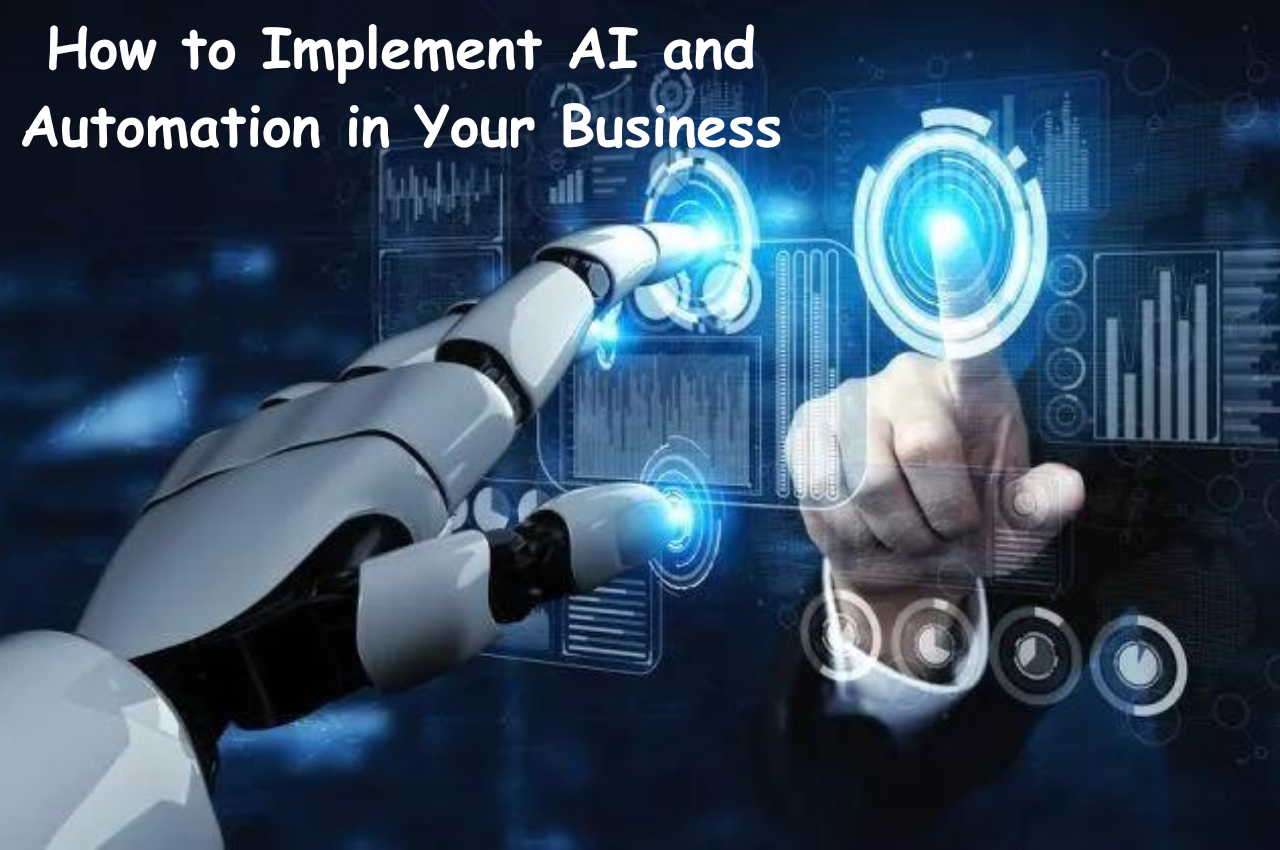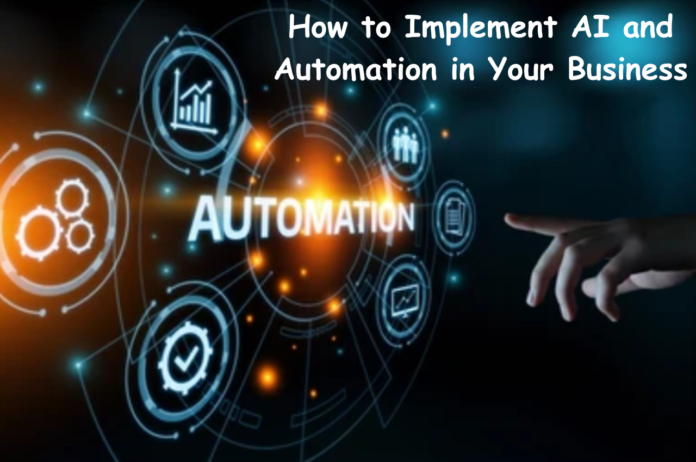Artificial intelligence (AI) and automation are two buzzwords that have been doing the rounds in the business world lately. These technologies are transforming the way business is conducted and providing enormous benefits to organizations that adopt them. In today’s article, we will discuss how to implement AI and automation in your business. So let’s begin-
Thank you for reading this post, don't forget to subscribe!What Is AI?
Before you know how to apply AI to your business, you must know what is Artificial Intelligence or AI? AI, or Artificial Intelligence, is the ability of machines to perform tasks that normally require humans to complete. OpenAI Playground and ChatGPT are examples of AI, as they are large language models that can understand and create language according to human needs. After long training these models can improve over time using large amounts of data and complex algorithms. Among the many uses of AI are natural language processing, image recognition and predictive analytics.
AI can help businesses make better decisions by analyzing large amounts of data and providing insights and recommendations, which can be more profitable for your business. For example, AI-powered chatbots can provide 24/7 customer support and personalized recommendations based on customer data, making it easier for you to achieve customer satisfaction. If you want, you can use AI to analyze financial data and make strategic decisions.
What Are the Advantages of AI in Business?
AI and automation offer several advantages for businesses, including-
- Increased Efficiency: Automation streamlines repetitive tasks, reducing the time and effort required to complete them. AI algorithms can optimize processes and workflows, leading to improved productivity and faster turnaround times.
- Cost Reduction: By automating manual tasks, businesses can save on labor costs. AI-powered systems can also help in resource allocation, inventory management, and predictive maintenance, leading to cost savings in various operational areas.
- Enhanced Accuracy: AI algorithms can perform tasks with a high degree of accuracy and consistency, minimizing errors compared to human counterparts. This is particularly beneficial in tasks like data entry, analysis, and quality control.
- Improved Decision Making: AI can analyze vast amounts of data quickly and derive insights that humans might miss. This enables data-driven decision-making, leading to better strategies, optimized operations, and improved customer experiences.
- Personalization and Customer Experience: AI enables businesses to personalize their interactions with customers based on their preferences, behaviors, and past interactions. This leads to more tailored products, services, and marketing campaigns, enhancing overall customer experience and satisfaction.
- Scalability: Automated systems and AI algorithms can scale up or down easily to handle fluctuations in demand, without the need for significant manual intervention. This flexibility allows businesses to adapt to changing market conditions more effectively.
- Innovation: AI technologies can foster innovation by enabling businesses to explore new ideas, develop novel products and services, and discover more efficient ways of operating. This can lead to a competitive edge and long-term growth opportunities.
- Risk Mitigation: AI can analyze data to identify potential risks and anomalies, helping businesses to proactively mitigate risks such as fraud, cybersecurity threats, and compliance issues.
- Employee Empowerment: Automation can free up employees from repetitive tasks, allowing them to focus on more strategic, creative, and value-added activities. This can lead to higher job satisfaction, skill development, and overall employee morale.
- 24/7 Operations: AI-powered systems can operate round the clock without human intervention, ensuring continuity and availability of services, particularly in industries like customer support, healthcare, and finance.
What is Business Process Automation?
Business process automation is about ensuring maximum use of technology to automate business processes to save time. HubSpot and Ontraport are examples of BPA tools that automate various business processes. HubSpot’s Marketing Hub, for example, automates email marketing, social media posting, and lead posting. Ontraport, on the other hand, is CRM and business process automation software designed to scale businesses by providing them with all the tools they need to sell, market and manage their business online.
Business process automation software can help businesses reduce costs by automating routine tasks, freeing up employees to focus on more complex and high-value activities. It can improve accuracy and efficiency by eliminating manual errors and streamlining workflows that help them survive the competitive battle. By automating business processes, companies can improve ROI, enhance customer experience, and achieve adequate goals in their industry.
Read More: AI in Automation: What You Need to Know
Overall, business process automation enables organizations to save costs, improve accuracy, accelerate processes, and allocate human resources to more strategic and value-added tasks.
How to Implement AI and Automation in Your Business
Implementing AI and automation in your business can significantly enhance efficiency, productivity, and decision-making processes. Here’s a step-by-step guide to help you get started-
Assess Your Needs and Goals
Identify areas in your business where AI and automation can make a meaningful impact. This could be in customer service, sales, marketing, operations, or other departments. Set clear objectives for implementing AI and automation. Whether it’s reducing costs, improving customer experience, or streamlining processes, having specific goals will guide your implementation strategy.
Educate Yourself and Your Team
Gain a basic understanding of AI and automation technologies and how they can benefit your business. Educate your team about the potential changes that AI and automation will bring to their roles and responsibilities. Encourage them to embrace the new technologies and provide training as needed.
Start Small and Scale Up
Begin by implementing AI and automation in one or two areas of your business rather than trying to transform everything at once. This allows you to test the technologies, evaluate their effectiveness, and make adjustments as needed before scaling up. Choose pilot projects that have the potential for significant impact and are relatively easy to implement.
Select the Right Tools and Technologies
Research and select AI and automation tools that best fit your business needs and goals. Consider factors such as functionality, scalability, ease of integration, and cost. Leverage both off-the-shelf solutions and custom-developed solutions, depending on your requirements.
Integrate AI and Automation into Existing Processes
Integrate AI and automation seamlessly into your existing workflows and processes. This may require making adjustments to your systems, software, and procedures. Ensure that AI and automation complement human work rather than replacing it entirely. The goal is to enhance human capabilities, not eliminate jobs.
Monitor and Measure Performance
Continuously monitor the performance of your AI and automation initiatives against the established objectives. Track key metrics such as cost savings, productivity improvements, and customer satisfaction. Use analytics and reporting tools to gain insights into the effectiveness of the implemented technologies and identify areas for optimization.
Iterate and Improve
Based on the insights gathered from monitoring and measurement, iterate on your AI and automation strategies to further optimize performance. Solicit feedback from employees, customers, and other stakeholders to identify areas for improvement and address any concerns or challenges.
By following these steps, you can effectively implement AI and automation in your business to drive innovation, efficiency, and growth.
AI and Automation Tools You Should Use in Your Business
AI and automation tools can significantly increase efficiency and productivity across various business functions. Here are some essential tools you should consider integrating into your business. CRM platforms like Salesforce, HubSpot, or Zoho CRM leverage AI to streamline customer interactions, manage leads, and improve the sales process. Marketing automation tools such as Mailchimp, Marketo, or HubSpot automate email marketing campaigns, lead nurturing, social media scheduling, and analytics, saving time and effort in marketing activities.
 Using chatbots like Intercom or Zendesk Chat for customer support or virtual assistants like Google Assistant or Amazon Alexa for various tasks can provide instant feedback and streamline communication processes. Tools like Tableau, Power BI, or Google Analytics help make data-driven decisions by analyzing large datasets, generating insights, and visualizing trends. Workflow automation platforms allow you to automate repetitive tasks by integrating different apps and services without the need for coding.
Using chatbots like Intercom or Zendesk Chat for customer support or virtual assistants like Google Assistant or Amazon Alexa for various tasks can provide instant feedback and streamline communication processes. Tools like Tableau, Power BI, or Google Analytics help make data-driven decisions by analyzing large datasets, generating insights, and visualizing trends. Workflow automation platforms allow you to automate repetitive tasks by integrating different apps and services without the need for coding.
NLP tools such as IBM Watson or Google Cloud Natural Language Processing enable businesses to analyze and understand unstructured data from text sources, such as customer feedback, social media or documents. Tools like RapidMiner or IBM SPSS Modeler use AI algorithms to analyze historical data and predict future trends, helping businesses make proactive decisions in areas such as sales forecasting, inventory management or risk assessment.
Integrating these AI and automation tools into your business processes can streamline operations, improve decision-making, enhance the customer experience, and ultimately drive growth and innovation. However, it is essential to carefully evaluate your business needs and choose the tools that best suit your needs and budget. Additionally, proper training and implementation are crucial to maximizing the benefits of this technology.
Final Words
After reading the entire article, you have understood by now, how to apply AI and automation in your business, right? Successful implementation of AI and automation in your business requires careful planning. Businesses can effectively integrate AI into their operations and benefit from improved efficiency and productivity by following the steps outlined in this guide, which will help them become economically stronger and profitable. Thank you very much for reading today’s full article with Technocommy, we are your one and only destination to get updates about the latest information in technology.



Comments are closed.